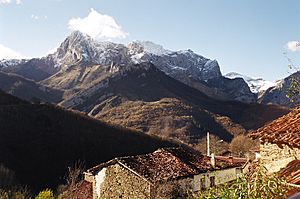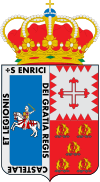Ponga, Asturias facts for kids
Quick facts for kids
Ponga
|
|||
|---|---|---|---|
 |
|||
|
|||
 |
|||
| Country | |||
| Autonomous community | |||
| Province | Asturias | ||
| Comarca | Oriente | ||
| Judicial district | Cangas de Onís | ||
| Capital | San Juan de Beleño | ||
| Area | |||
| • Total | 205.98 km2 (79.53 sq mi) | ||
| Highest elevation | 2,142 m (7,028 ft) | ||
| Population
(2018)
|
|||
| • Total | 598 | ||
| • Density | 2.9032/km2 (7.519/sq mi) | ||
| Demonym(s) | pongueto/a | ||
| Time zone | UTC+1 (CET) | ||
| • Summer (DST) | UTC+2 (CEST) | ||
| Postal code |
33557
|
||
Ponga is a small town and a special area (called a municipality) located in the beautiful region of Asturias, in northwestern Spain. Its main village, or capital, is called San Juan de Beleño.
Contents
Ponga's Nature and Wildlife
Ponga is home to a wonderful natural park. This park helps protect the amazing plants and animals that live here. The area known as “Ponga-Amieva” is also a special place for wild birds. It's called a Special Protection Area because it helps keep many different bird species safe.
A Look Back: Ponga's History
We know people lived in the Ponga area a very long time ago. Old tools and other items found here show that people were already living in this region during the Bronze Age. Later, when the Roman Empire expanded, Ponga became part of the Roman territory of Cantabria. The first time Ponga was mentioned in official writings was during the rule of Alfonso IX of León, a king from long ago.
Ponga's Villages and Areas
Ponga is divided into nine smaller areas, which are like local villages or districts. These are called parishes. Each parish has its own unique charm and history.
|
|
|
Fun Facts About Ponga's Culture
Art and Architecture
Ponga has some interesting old buildings and art, especially in its churches. These places show off the history and art of the region. Some notable examples include:
- The Church of Santa María de Tarañes, built in 1779.
- The Church of Santa María de Viego.
- The Church of San Juan de Beleño, which dates back to the 17th century.
- The Ermitas (small chapels) of Ventaniella and Arcenorio.
- The historic Bucket Tower.
- The grand Sobrefoz Palace.
- The Spa Mestas, a place for relaxation.
Festivals and Celebrations
Throughout the year, Ponga celebrates many traditional holidays and festivals. These events are a great way to experience the local culture and have fun!
- January 1: The Feast of Aguinaldo and Guirria in San Juan de Beleño. This festival is so special it's been declared a regional Fiesta de Interés Turístico (a festival of tourist interest).
- Carnival Saturday: Aguinaldo de Sellaño is celebrated during Carnival.
- Holy Saturday: A market called Trasiegu takes place in Sobrefoz.
- May 13: A special cheese contest and "Ponga Beyos days" celebrate the famous Beyos Cheese in San Ignacio.
- Around May 15: The festival of San Isidro Labrador is held in San Juan de Beleño.
- July 1: The festival of San Pedro is celebrated in Sobrefoz.
- July 16: Nuestra Señora del Carmen is honored in San Juan de Beleño.
- July 31: Festivals for San Ignacio de Loyola and Carangas Beyos take place.
- August 4, 5 and 6: The festival of Nuestra Señora de las Nieves is celebrated in Ladle and Sellaño.
- August 9: San Justo is celebrated in Cadenava.
- August 10 and 11: The festival of San Lorenzo takes place in Abiego.
- August 15 and 16: Our Lady is celebrated in Tarañes and Viego.
- Last weekend of August: The Arándanu (Blueberry) festival is held in Bedules.
- September 1: La Santina de Ventaniella is celebrated in Ventaniella. This honors Our Lady of Covadonga, who is the patroness of Asturias and is often called “La Santina”.
- September 8: La Santina de Arcenoriu is celebrated in Arcenoriu.
- Last weekend in November: Gastronomic Days of Hunting are observed throughout the entire area.
See also
 In Spanish: Ponga para niños
In Spanish: Ponga para niños





